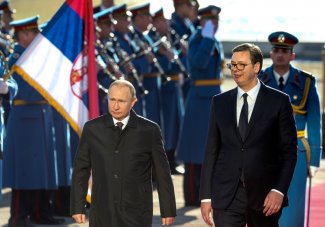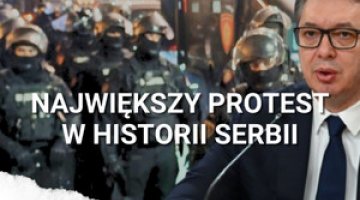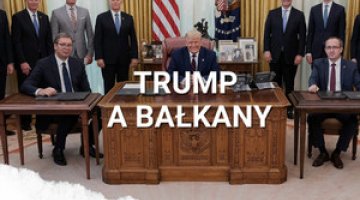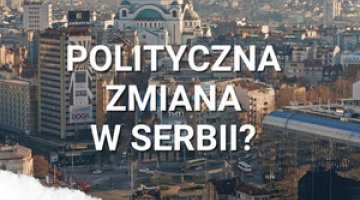Putin in Belgrade: enthusiasm instead of specifics

On 17 January President Vladimir Putin paid an official visit to Serbia, where he met President Aleksander Vučić. The Russian president was accompanied by a large delegation of government and business representatives. During the visit, more than twenty cooperation agreements were signed, principally in the economic and scientific fields, but almost all of them were non-binding memoranda. They provided for the modernisation of Serbia’s railway and hydropower infrastructure, among other projects. Russian Railways International signed a contract worth €230 million with Serbian railways. Announcements were made on deepening scientific cooperation, as well as in the fields of digitisation & new technologies and energy.
The visit is part of the ongoing Serbian-Russian diplomatic relationship, which has been very intensive since 2012. Both sides are willing to demonstrate their close relations. The main fields of cooperation between the two countries are energy and the case of Kosovo, whose independence neither Serbia nor Russia recognises.
Commentary
- The visit did not lead to the signing of any binding agreements deepening cooperation between the two countries. Serbia is reluctant to make commitments that would jeopardise its cooperation with the EU and NATO. The vast majority of the agreements signed are non-binding in nature, and relate to the continuation of previous initiatives. On the occasion of this visit Russia was able to present itself as a country which is developing advanced technologies.
- For Russia, the visit to Serbia was intended to serve as a demonstration of its influence in the Western Balkans region. However, Moscow’s resistance has not prevented Montenegro from gaining NATO membership or stopped the process of rapprochement between Greece and Macedonia, which will probably open the path for Skopje to join the Alliance. On the other hand Serbia, through its cooperation with Moscow, is bolstering its position towards the EU and NATO as well as the entire Western Balkans region, especially in relation to Kosovo, which it still does not recognise.
- For Serbia, Putin’s visit served to deflect the pressure from the US and EU to normalise its relations with Kosovo by way of a binding agreement. In recent months Serbia has undertaken active measures to weaken Prishtina’s position on the international stage and blame Kosovo for the failure of the talks on normalising relations. The Serbian authorities would prefer to draw out those talks, but it cannot be ruled out that that they will ultimately be forced to reach an agreement. In this context, Putin’s visit was intended to be a demonstration of support for Serbia before the final talks, both on the international arena and in the domestic context. The nationalist and pro-Russian opposition in Serbia has accused Vučić of betraying Serbian interests in Kosovo.
- Russia is concerned that an agreement between Belgrade and Prishtina might emerge, which would seriously weaken Moscow’s influence in the region, as well as its ability to put pressure on Serbia. Russian diplomats have officially expressed their disapproval of any agreement negotiated by Belgrade and Pristina based on a change of borders and exchange of territories between Kosovo and Serbia. In Moscow’s opinion, such an agreement would violate the UN Security Council resolution adopted back in 1999 which regulates Kosovo’s status. It therefore seems that Russia is interested in joining the negotiation process so it can directly influence its course, thus gaining an additional opportunity to block any agreement. In this context, both parties’ interests in Kosovo are at odds with each other, and the government in Belgrade cannot count on Moscow’s unconditional support on the Kosovo question.
- A key area of cooperation for Serbia and Russia is energy. Serbia wants the route of the proposed overland extension (400 km) of the Turkish Stream gas pipeline to run through its territory, but it cannot finance its construction.. Putin’s visit brought some progress in this regard: he declared that Russia is ready to invest US$1.4 billion in a transit gas pipeline in Serbia, but the final decision will depend on the conditions of implementation, including the financing. Meanwhile, the two sides signed a memorandum to expand the gas storage facility in Banatski Dvor to 750 million m³ (from the current 450 million m³), which the Serbian side had been hoping for. In turn, Gazprom’s CEO Aleksei Miller said that Russia is ready to significantly increase its supply of gas to Serbia after the transit gas pipeline is constructed (this is supposed to happen in 2019, which is unlikely). The visit indicates Russia’s strong interest in constructing an export branch of the Turkish Stream pipeline. Its final route is still not a foregone conclusion, something which Moscow will use to put pressure on the states interested in the project; the aim is that they will lobby EU institutions in order to obtain the conditions for the project’s implementation which are most favourable to Russia, including in particular an exemption from the regulations of the Third Energy Package.
- Another area of Russian-Serbian cooperation is religious issues. The Serbian Orthodox Church is particularly concerned that the granting of autocephaly to the Orthodox Church in Ukraine will strengthen similar efforts on the territory of the former Yugoslavia, where the local Orthodox churches are now under the jurisdiction of the Serbian Patriarchate. This is most likely the reason why part of the ceremony took place in St. Sava’s Church, the largest in Serbia, in order to demonstrate Moscow’s support for Serbian Orthodoxy, and why Russia has pledged further financial support (€5 million) for the church’s expansion.
- The spectacular setting of President Putin’s visit to Serbia served not only to ingratiate the country with Russia, but also to demonstrate the scale of support among Serbian society for President Vučić, in the context of the mass protests which have been taking place in Serbia since the end of November 2018. The ruling Serbian Progressive Party ensured the participation of large numbers of government supporters, to show that they far outweigh the number of its opponents (tens of thousands of protesters have been involved in each opposition rally).
- Certain issues in relations between the two countries seem to be unresolved. Despite growing sympathy for Russia and disappointment with the EU, Moscow’s efforts to weaken Serbia’s cooperation with the EU and NATO seem to have little chance of bearing fruit. Russia wants Serbia to sign an agreement on creating a free trade zone with the Eurasian Economic Union by the end of the year, but Belgrade is reluctant to undertake initiatives of this type because they could hinder the completion of its process of accession to the EU. The Serbian government wants to continue reaping the benefits of close relations with both the EU & the US, and with Russia.




